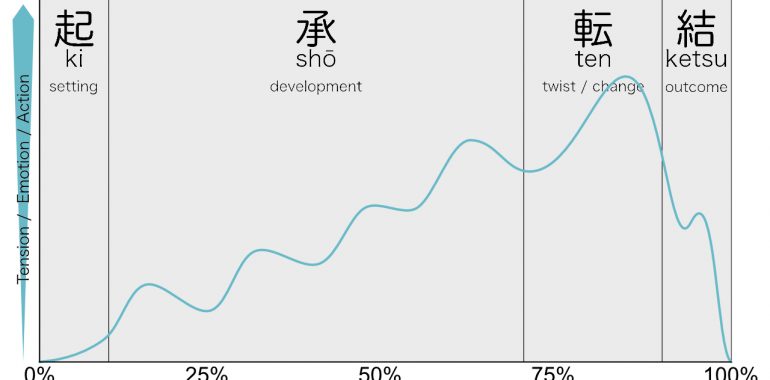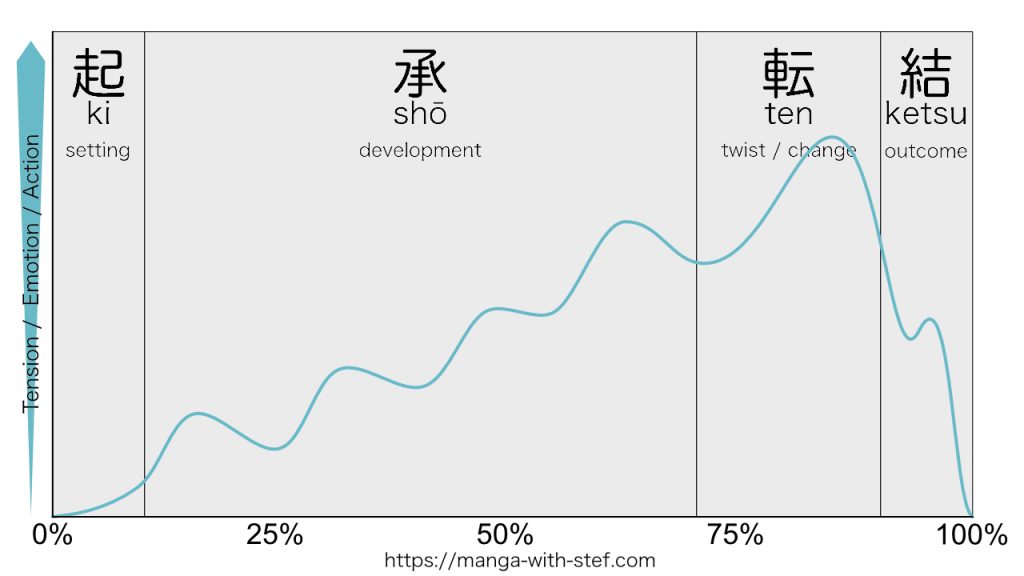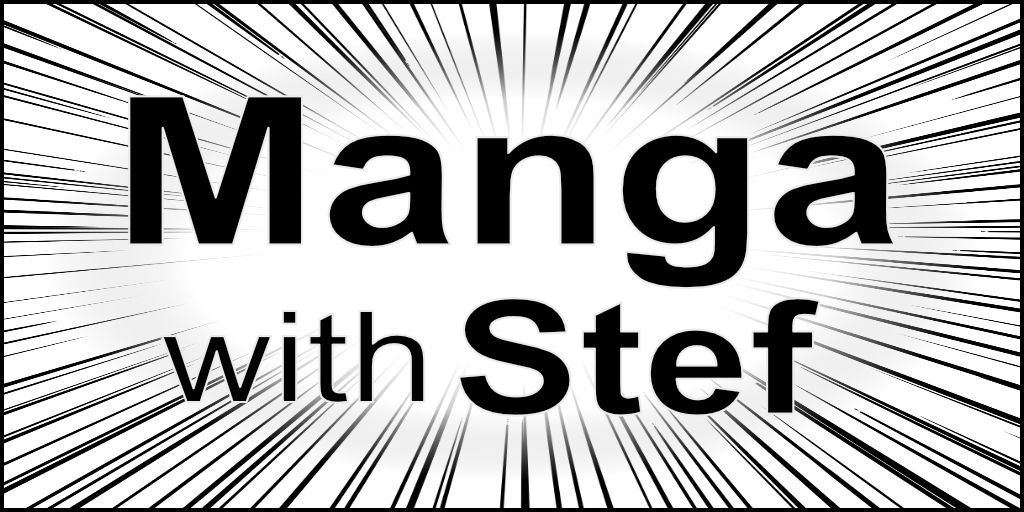Using the kishōtenketsu Story Structure in Manga

Using the kishōtenketsu Story Structure in Manga
The kishōtenketsu (aka kishōtengō) is a Japanese story structure inherited from China. It is made of 4 parts: the opening, the development, the twist or change, and the conclusion.
Let’s learn more about this structure and see how it can be used in your manga stories.
The kishōtenketsu story structure
As indicated in the introduction the kishōtenketsu (起承転結) is a four acts story structure.
It appeared in the 16th century following a Chinese structure used to build 4 lines poetry, somehow similar to a Japanese haiku. Later, in the 19th and 20th century, it was slightly modified and adapted for new domains.
The 4 lines, named ku (句 – meaning phrase, sentence, passage), are:
- kiku (起句) where ki (起) means to rouse, wake up.
- shōku (承句) where shō (承) means to hear, listen to, receive.
- tenku (転句) where ten (転) means to turn around, change.
- kekku (結句) where ketsu (結) means to tie, bind, join.
Original usage
In its original poetry form, the kishōtenketsu is used as follows:
- the kiku sets the scene, introducing facts or events.
- the shōku builds on these facts or events, highlighting a specific element.
- the tenku highlights a seemingly unrelated element.
- the kekku, finally, makes the link between the two highlighted elements.
Example of work
Here is a Japanese folk song that perfectly illustrates this original usage:
大阪 本町 糸屋 の 娘 – Ōsaka Honmachi itoya no musume
The daughters of the yarn seller in Honmachi, near Ōsaka
姉 は 十六 妹 が 十四 – ane wa jū roku, imoto wa jū shi
The oldest is 16, the youngest only 14
諸国 大名 は 弓矢 で 殺す – shokoku daimyo wa yumiya de korosu
The feudal lords of various regions kill with bows and arrows
糸屋 の 娘 は 目 で 殺す – itoya no musume wa me de korosu
The daughters of the yarn seller kill with their eyes
Explanation
As you can see:
- The first line, kiku, states the fact that the yarn seller of that town near Ōsaka had daughters.
- The second line, shōku, highlights the fact that these two girls were quite young, being 16 and 14.
- The third line, tenku, suddenly changes subject. It now speaks of the feudal lords of that time, and of the manner they killed people using bows and arrows. The fact that the author states something apparently unrelated makes the reader wonder how this can relate to the initial topic. This is a way to create expectations and interrogations in the reader’s mind, thus creating some kind of tension.
- The fourth line, kekku, finally makes the relation, bringing the answer. The two girls can as surely take a man’s heart with a glimpse of their eyes as the feudal lords’ arrows can kill.
Contemporary usage
In its later and more contemporary form, the kishōtenketsu is used as follows:
- the kiku (起句) is the opening part, setting the scene and introducing the characters.
- shōku (承句) is the development part, highlighting an event or incident involving the characters and that builds up.
- tenku (転句) is the changing part, the twist, leading the story to its climax, and tipping over to its conclusion.
- kekku (結句) is the outcome part, showing the consequences and transformation of the event and characters.

Here we have something closer to the 3-acts structure used in plays and movies. Note though that the fact that we have four acts and not just three makes the approach slightly different.
The setup, conflict and resolution.
Usage of the in manga
Now, let’s see how you can use the kishōtenketsu for your manga stories.
Yonkoma
Firstly, the kishōtenketsu makes the structure particularly appropriate for a yonkoma (four panels) manga story. Each panel in the yonkoma can be matched to a part in the kishōtenketsu. The first panel sets the scene, the second one highlights an element, the third one
Short stories and series
You can also use the kishōtenketsu structure in your manga stories. The structure can be used both for each chapters of your manga, as well as over a set of chapters.
Within a chapter, this helps making the chapter interesting by giving it some tension and dynamic. And over a set of chapters constituting an arc, this should be used to gradually build up the tension before the outcome of the arc.
Parts proportion within a manga story
One point of attention, though, is that you should not give the same duration to each part. Doing so would make the setup act (kiku) too long and boring, and the development act (shōku) too short.
Similarly to how the second act (confrontation part) of the 3-acts structure shall be longer, you should give preponderance to the second act (shōku) of the kishōtenketsu. It shall start quite early to avoid the setup (kiku) to be too long. And it shall last to allow tension to gradually build up. Finally, you should give the last third or quarter of your manga story to the last two parts (tenku and kekku, the twist and outcome).
This ratio could be for instance:
- 10% for the introduction (kiku),
- 60% for the development (shōku),
- 20% for the twist/change (tenku)
- and 10% for the outcome (kikku).
Basically, for a 20 pages chapter, this would give approximately:
- kiku: 2 pages
- shōku: 12 pages
- tenku: 4 pages
- kekku: 2 pages
Of course, these figures are indicative, but see that the development part, and then the twist part, shall be given the more room.
Do not hesitate to ask questions or to comment.
See you!
Stef
